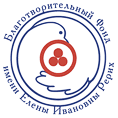Serge Skorodumov. The Indian Odyssey of Gerasim Lebedev
Serge Skorodumov
|
…Под древом жизни храм тебе назначил Бог, Шанкара. Мохамудгара (Молот, сокрушающий заблуждение). Перевод Герасима Лебедева |
Truth Alone Triumphs
In the historical museum of the ancient Volga city of Yaroslavl, two interesting images coexist: a bear with an axe, the symbol of the city, and a column of the Indian king Ashoka with lions and an inscription in Sanskrit "Truth Alone Triumphs”. The museum is indebted to Gerasim Lebedev (1749–1817) from Yaroslavl for the combination of the images which are so far apart from one another. At the beginning of the 19th century, there was no person in Russia whose knowledge about India was as vast as that of Gerasim Lebedev’s. His works served as a basis for a new science of Indology.
What do you think is the very first description of India? The description that became the property of the cultural and scientific community of Russia? We‘re guessing most of the readers will immediately recall the travel records of the Tver merchant Afanasy Nikitin "A Journey Beyond the Three Seas." And they will be wrong. Because the work of Gerasim Lebedev "An Impartial Contemplation of the Brahmins’ systems of East India, their sacred rites and folk customs,” published in 1805, was the first one. The notes of Afanasy Nikitin entered the scientific circulation thanks to the efforts of outstanding historian N.M. Karamzin only 16 years later.
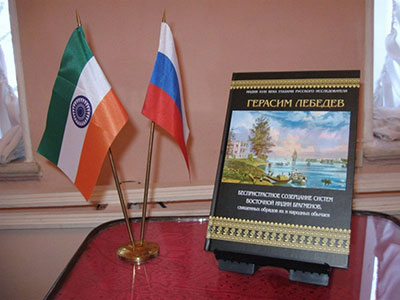
|
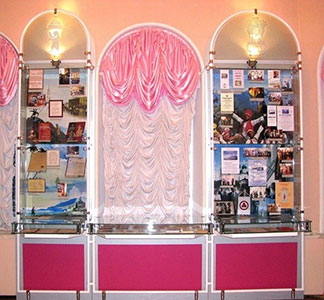
|
|
|
Book by Gerasim Lebedev |
Exhibition complex at the Museum of the History |
And if Afanasy Nikitin described in his "Journey ..." the land of Brahmins, which he visited in the 15th century and which by the beginning of the 19th century had not existed for a long time on the map, then Lebedev brought the most recent impressions about India, and outlined them in a number of his scientific works. In fact, "Impartial Contemplation ..." was the first review written directly by a Russian scientist who personally visited this distant and mysterious country. His book can be called an encyclopedia of India of those times. Lebedev's work is known to be translated into French and German. For the Russian society, which at that time knew almost nothing about India, his work became a source of knowledge about the spiritual culture of this country, the manners and customs of its people, the calendar, the riches of that land, the state of Indian trade.
In those days, scientists and cultural figures of Russia showed the keenest interest in India. But there were no direct ties with this country, so attractive for Russians. All the literature about India had to be translated from English and German into Russian. In 1792 the Russian historian and writer N.M. Karamzin translated "Sakuntala" by the great Indian poet Kalidasa - a wonderful monument of Indian culture. After Charles Wilkins translated "Bhagavad Gita" into English in 1785, it was published in Russian by N. Novikov's Printing House in 1788 in Russian with an ornate title "Baguat-geta, or conversations of Krishna with Arjuna, with notes. Translated from the original, written in the ancient Brahmin language, called Sanskrit, into English, and from this into the Russian language." One can imagine what interest could arouse the book of Gerasim Lebedev, the first Russian researcher who visited India.
Indian Theater of the Russian Pilgrim
The biography of Gerasim Lebedev is also unusual. He was born in 1749 in Yaroslavl in the family of a priest and was a younger contemporary of the founder of the Russian national theater Fyodor Volkov. Gerasim Lebedev was likely to rush to distant overseas countries since he was a child. Indian merchants visited Yaroslavl back in the 17th century. They came to the ancient Russian city from Astrakhan, where an Indian colony already existed at that time.
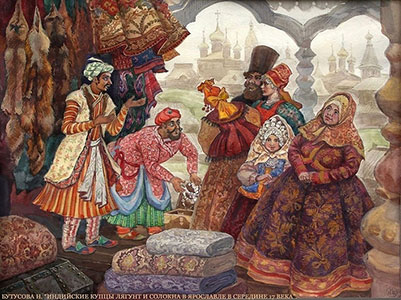 |
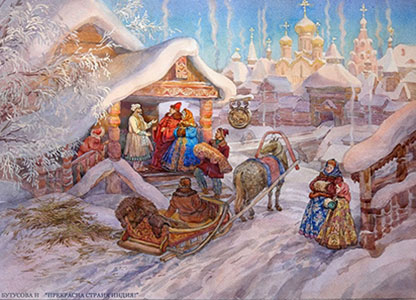 |
|
|
N. Butusova. Indian merchants Lyagunt and Solokna |
N. Butusova. India is beautiful |
At the age of 15 Lebedev moved to his father to St. Petersburg. He learned to read and write and made great strides in music. His cello mastery was combined with outstanding scientific abilities and a penchant for comprehending foreign languages. In 1777, at the invitation of Count A.K. Razumovsky, Lebedev went to Naples as a musician of the ambassadorial orchestra. And from 1777 to 1782 he performed at the courts of a number of European states.
On February 12, 1785 (old style) Lebedev went from England onboard the sailing ship “Rodney” to India. At that time India was an English colony. On August 15 he arrived in Madras. In Lebedev's words his stay in this city was harmonious and pleasant. But the "ancient science of the Brahmins", to which he aspired so much, remained inaccessible to him. There were no Indians who could translate into English books containing the wisdom of the ancient country. The Brahmans considered it a great sin to teach Sanskrit to representatives of the lower castes, and, moreover, to foreigners.
A thirst for knowledge led Lebedev further and further. The next city where he moved two years later was Calcutta – the capital of British India. Help came in 1789. Gerasim Lebedev met the teacher Goloknath Das, from whom he began to take classes of Hindustani, Sanskrit and Bengali, and in addition to the salary taught him European music in return.
Having lived in India for 12 years, Gerasim Lebedev acquired serious knowledge of Indian religion, mythology, cosmogony, literature, and music. He translated two comedies from English into Bengali, those of "Pretense" by V.P. Jordrell and "L'Amour médecin" by Moliere, adapting them for Indian audiences.
 |
 |
|
|
T. Daniel. Council House Street. Calcutta |
T. Daniel. Chitpur- Road. Calcutta |
In Lebedev's interpretation, the action of the comedy "Pretense" was transferred from Venice to India. Bengalis became the heroes of the play. To check the accuracy of the texts, Gerasim Lebedev asked the learned pandits to read his translations and they fully appreciated them. Then in Calcutta Lebedev decided to stage theatrical productions of the plays he had translated. Perhaps the example of his compatriot and contemporary, the Yaroslavl resident Fyodor Volkov, played a part here.
Probably, Gerasim Lebedev could not even imagine what difficulties and trials awaited him on the path of educational activities. The Englishmen he knew considered this new venture unreliable and even dangerous. The East India Company refused to provide him with the premises of their theater for staging, seeing a competitor in him. His plans were called quixotic. Then Lebedev rented a building on Dom-Tolla Street, 25, converted it into a theater with a two-story auditorium that could accommodate more than 300 people. For this, Gerasim Lebedev had to become an architect and even a supervisor of construction work. Like his compatriot Fyodor Volkov in Yaroslavl he had to paint screens in Bengali style in Culcutta.
Bengali actors and actresses played in the theater. There were ten men and three women, as well as a musical troupe of ten musicians. On November 27, 1795, the first performance of the scenes from the comedy "Pretense" took place. The performance included songs to the verses of the famous Bengali poet Bharot Chondro Raya. The music for them was written by Lebedev himself.
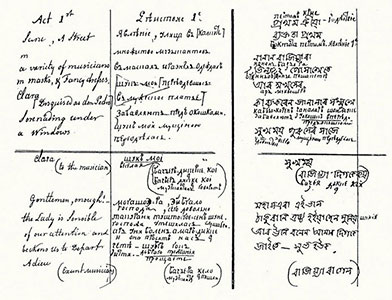 |
 |
|
|
Notebook of Gerasim Lebedev |
A billboard in Bengali about the first performance |
“The meeting was so crowded that if my theater was three times larger, of course, it would be full,” he recalled. The second time, on March 21, 1796, the play was shown in full and aroused great interest among the Bengali public. Gerasim Lebedev received permission from the governor to stage English plays. As he wrote, "the fortune carried me on the wings."
But in the eyes of colonial society, Lebedev's activity in organizing performances for the natives, which were customary to be looked down, was beyond all the horizons. His enemies developed a whole plan to ruin the theater and even tried to burn it down. Lebedev decided to seek justice in court. The English justice system was considered exemplary. But the truth was not achieved. The flywheel of the conspiracy continued to spin with unprecedented force.
On April 2, 1797, Gerasim Lebedev was even arrested. And although he managed to defend his honor, legal battles undermined his health and ruined him. Former high-ranking friends (including the Mayor of Calcutta, Colonel Alexander Kid and Supreme Court Justice John Hyde) practically turned their backs on Lebedev. In the first half of May 1797 the theater equipment had to be disassembled and sold. However, even in these difficult conditions, he retained his fortitude. Gerasim Lebedev wrote, "You should know, however, I am not complaining about the well-bred society, but only about those who dishonor a commendable name of their State..."
“He was the first of the sons of Russia ..."
At the end of 1797, Lebedev, ruined and sick, decided to return to Europe. On November 25, he sailed for Europe on the frigate of the East India Company "Lord Tarlow" under the command of Captain W. Thomson. Gerasim Lebedev took with him a small bale of gifts to friends and acquaintances (worth only 271 rupees), manuscripts of his writings and a priceless treasure - a collection of unique Indian manuscripts, which later became a part of the first collection of Schilling von Cannstatt in the Asian Museum of the Russian Academy of Sciences.
The ordeals continued. In February 1798, Lebedev was forced to go ashore at the Cape of Good Hope because of bullying and cruel treatment from Captain W. Thomson. Gerasim Lebedev filed a complaint with the governor, but the proceedings ended in vain for him. To make money on the road, Lebedev had to give five concerts. On November 4, 1798, he sailed from the Cape of Good Hope, and on December 3, Lebedev took part in a concert on Saint Helena Island, and on February 4, 1799, he arrived in London. It seemed that life was testing him for strength and loyalty to his chosen cause.
Returning to Russia, Gerasim Lebedev opened in 1804 a Printing House with a typesetting Bengali font on Bogadelnaya Street in St. Petersburg. It was the first and the only printing house of such kind in Europe. Subsequently, he published a number of his scientific works, including the famous study "Impartial Contemplation of the Brahmin systems of Eastern India, their sacred rites and folk customs."
Lebedev passed away on July 15, 1817. A significant part of his manuscripts, which were never published, have not survived to this day. He left no disciples behind him. The portrait of Gerasim Lebedev has not survived either. It seemed that all these years in Russia he lived in a race against time and circumstances... Lebedev's wife Anastasia buried him at the Georgievskoye (Bolsheokhtinskoye) cemetery in St. Petersburg. Lebedev's grave has been also lost. Only a memorial plate has remained, which is now in the museum of urban sculpture of St. Petersburg. The verses are carved on it:
“... He was the first of the sons of Russia
Who reached East India.
And having described Indian manners and customs
Brought to Russia their language…"
 |
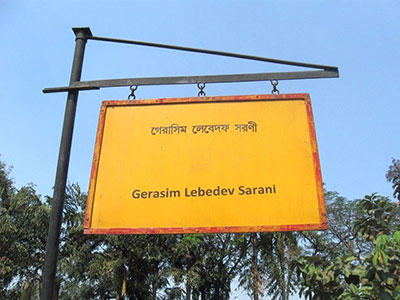 |
|
|
Marble tombstone with an epitaph |
Gerasim Lebedev’s street in Calcutta |
Unfortunately Gerasim Lebedev and his works were almost forgotten in Russia for a long time! In Yaroslavl, Lebedev's hometown, not everyone knows about him, his glorious biography and contribution to science even now. Is that not a reproach for Russians that India remembers Gerasim Lebedev, honors him as a great Russian cultural figure, the founder of the first theater of the European type and considers his activities as a symbol of Russian-Indian friendship? Indians write articles, books, dissertations about him, stage theatrical performances. One of the most beautiful streets in Calcutta (West Bengal) is named after him.
It is noteworthy that the outstanding orientalist George Roerich in his article "Indology in Russia" wrote about the merits of Lebedev in 1945. A decade later, in the mid-1950s, scientists discovered information about Lebedev in Russian archives, restored his biography, and found many documents. The works of Soviet orientalists K.A. Antonova, V.S. Vorobiev-Desyatovsky, L.S. Gamayunov and others were published. And there is one more landmark parallel. The scholar Mikhail Medvedev reported that in India the world-famous artist Svetoslav Roerich helped him in his work dedicated to Gerasim Lebedev in the National Archives of the Republic of India.
When the scientific contributions were published, the name of Lebedev immediately aroused great interest in Russia. Two novels have been written about him, those of "The Indian Dreamer" by Ye.L. Sternberg and “Gerasim Lebedev" by V.A. Smirnov – Rakitin. The famous playwright Edward Radzinsky dedicated his first play "My Dream ... India" to Gerasim Lebedev. The famous actor and filmmaker Rodion Nakhapetov intended to produce a feature film about Lebedev.
Long journey back home
It took another half century for Lebedev's "Impartial Contemplation ..." to find a second life in his hometown of Yaroslavl. Doing so has not proven to be easy. The path from the inception of the idea to republish the book nowadays to the concrete implementation to life took almost 10 years. It was necessary for a certain group of like-minded people, a kind of "critical mass", to gather to set with its collective energy this problem in motion.
A copy of one of the first copies of Lebedev's book published in 1805, was obtained from the State National Library thanks to the efforts of the workers of the Yaroslavl Roerich Society "Orion" and the friends from the St. Petersburg branch of the International League for the Defense of Culture. The drawings were scanned from a copy of the book in the Russian State Library in Moscow. The text had to be literally translated from Russian into Russian. After all, the language of the early 19th century differs markedly from the modern one. The book was filled with terms which the author had spelled out phonetically. Their deciphering took a lot of work and knowledge.
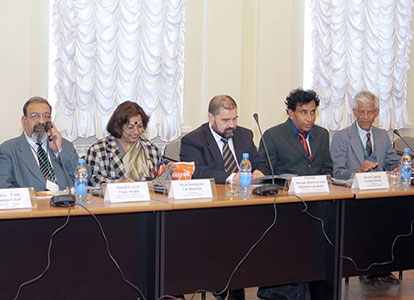 |
 |
|
|
Indian scientists in Yaroslavl |
International Scientific Conference |
The scientific preparation of the book for publication was carried out by the Doctor of Historical Sciences, Indologist V.V. Chernovskaya. She also brought from India reproductions of paintings by English artists of the late 18th - early 19th centuries, Charles Doyle, T. Daniel, W. Simpson, W. Hodges and James B. Fraser, which adorned the book. The originals of these paintings are in the Victoria Memorial in Kolkata. India on these reproductions appears to the reader exactly the same as Gerasim Lebedev saw it in his time. These reproductions create an amazing sense of presence. It seems that you find yourself 200 years ago and, together with the author of the book, travel to an amazing and mysterious country, get acquainted with its culture and customs. In one of the views of Kolkata one can even see the house near the Church of St. John where Gerasim Lebedev lived.
The Yaroslavl publishing house "Akademya Razvitiya" (“Academy of Development”), headed by M.A. Nyankovsky, prepared Lebedev's book for publication in excellent design. The constant support of the director of the Museum of the History of the City of Yaroslavl V. G. Izvekov allowed the project to be successfully completed.
On April 16, 2009, with the participation of representatives of the Embassy of the Republic of India in Russia, a presentation of a new edition of the book "An Impartial Contemplation of the Brahmin's systems of East India, their Sacred Rites and Folk Customs" took place at the Museum. A cello sounded in the front hall of the museum. The musical compositions of the times in which the scientist lived and worked were performed. Nicholas Roerich's Banner of Peace was raised above the museum, which has already become a traditional symbol of joint Yaroslavl-Indian cultural projects.
Columbus of Russian Indology
It would seem that today you can easily find any information about India. What is the interest of "Impartial Contemplation ..." now, more than 200 years after? The reader, opening a new edition of this book, will admire the wonderful world of India through the eyes of a Russian traveler of the late 18th - early 19th centuries. This was he who was the first Russian explorer of India and who actually founded a new science, which would later be called Indology. Are there any inaccuracies in his work? Lebedev himself wrote, "It is probable that the most diligent explorers of the systems and customs of Indians will find shortcomings in my works, as I did in the works of my predecessors. That’s why I do hope to be kindly excused. And I do hope that these mistakes will not be considered as the fault of the traveler fighting the storms for his Fatherland glory."
Almost at the very beginning of the book Lebedev defined the tasks of his research, and we understand why this was India that aroused such great interest in him. “East India,” the author wrote, “besides its abundance and treasures, at which not only Europe but perhaps the whole world looks with envious eyes, is that primordial part of the world, from which, according to the testimony of various chroniclers, the human race came and settled all over the entire globe; and from which the national Sanskrit language came, which has a very tangible convergence in the rules not only with many Asian, but also with European languages."
Lebedev was led by the idea of returning to ancient origins. He searched for common roots which once existed between us and which neither time nor distance could separate.
Analyzing Hinduism, Gerasim Lebedev was looking for similarities with Christianity. And he found them. He drew parallels between the Christian trinity and the trinity in Hinduism, between Krishna and Christ. Lebedev called the spiritual beings of Hinduism Angels, the term familiar to the Orthodox reader of his time, and the symbolism of the image of Durga an iconostasis. Figuratively speaking, long before Max Müller, who is considered the founder of modern religious studies, he carried out original religious studies.
Lebedev wrote that the Indians, “confessing one God in accordance with us, essentially revere Him in three indivisible and unmerged hypostases: both as creation, preservation and renewal of this world, they ascribe to the whole Holy Trinity and to each hypostasis His authority equal in power and strength."
Of course, today some of the Russian researcher’s conclusions from a scientific point of view may seem naive. But let’s confess whether we are right in the enlightened XXI century to consider our ideas about Hinduism as anything mythological and far distant from reality? Some modern theologians sometimes evaluate Hinduism ignorantly, and in any case, they are much more far from the truth than Lebedev was. Gerasim Lebedev explained why Indian symbolism seemed so strange and incomprehensible to Europeans. The reason was that "they cannot comprehend due to the lack of knowledge of the Sanskrit language."
In his book Lebedev gave a description of the rituals of Hinduism, temples, major holidays, Indian customs. It was with indignation that we read about the cruelty on the part of the representatives of the East India campaign and the enormous income that it received from India by predatory means. England bought many goods in Russia and then resold them to India. This was to establish trade relations between Russia and India for the benefit of his Fatherland, bypassing unwanted intermediaries, that Gerasim Lebedev was concerned about. In his letter to the Russian ambassador to England, S.R. Vorontsov, he even offered his services in establishing such contacts.
Lebedev drew attention to the antiquity of Indian civilization and described the brutal colonial policy of the British, "The Indians are not in the least like wild ones and they have more reason to reproach those who treat them most cruelly than the most bloodthirsty fierce beasts..."
Getting acquainted with the book, we follow with great interest how Gerasim Lebedev discovered the culture of India. And we discover the inner world of the author. And although researchers have not yet found a single portrait of Lebedev, his image clearly appears before us on the pages of his work. He has great sympathy for the Indians. Being far from home, he always concerned about the good of the Fatherland.
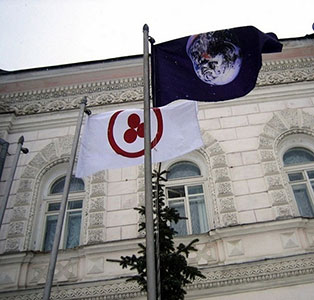 |
 |
|
|
The Banner of Peace and the Flag of the Earth |
A. Kharlamova-Sibrina. |
And moving from page to page, you begin to understand that Russia's love for India is the innermost trait of the Russian soul and the Russian character. It is indestructible neither for centuries, nor for circumstances. In our peoples separated by thousands of kilometers there is some kind of elusive consonance. Lebedev hoped very much that his book would serve to establish "the mutual connection of the friendliness desired by people" and "the restoration of universal peaceful good."
It is probably not for nothing that N.M. Karamzin wrote in the preface of his translation of Sakuntala, “The creative spirit does not inhabit Europe alone; it is a citizen of the Universe. Man is everywhere man; everywhere he has a sensitive heart, and in the mirror of his imagination he contains heaven and earth. "
In December 2009, the Museum of the History of the City of Yaroslavl hosted a large-scale Russian-Indian scientific forum "Gerasim Lebedev and His Time", which was attended by representatives of the scientific community from Moscow, St. Petersburg, Yaroslavl, Delhi, Ahmedabad, Kolkata. There were nine doctors and seven candidates of sciences among them. In the resolution of the conference scientists proposed to raise the Banner of Peace and the Flag of the Earth over the Museum of the History of the City of Yaroslavl as "symbols of the enduring Russian-Indian friendship and the assertion of the leading and unifying role of culture in the development of the dialogue between the civilizations of East and West."
This wish was fulfilled, and since 2009 the Banner of Peace and the Flag of the Earth have been constantly flying over the museum. They remind of the cultural ties between Yaroslavl and India and that the Museum of the History of the City of Yaroslavl is the center of attraction of these ties.
The public of Yaroslavl came up with the initiative to name one of the city streets after Lebedev and to erect a monument to him, and to propose to the Indian city of Kolkata to become Yaroslavl's sister city. Someday this will surely happen.
And today his book became the best monument to Lebedev, from the pages of which the author after a long oblivion turns to us through the centuries. "... Both at the beginning and during my journey, the main goal of my labors was the improvement of my natural inclinations, the glory and benefit of my Fatherland."
Scientists call Gerasim Lebedev "The Columbus of Russian Indology." He worked in hope that his labors would serve as reciprocal linkages of the "friendliness desired by people" and "the restoration of the universal and peaceful good." And it came true. Having united East and West with his life, he opened the way to India for the scientists of Russia and proved the correctness of the ancient wisdom, carved on the column of King Ashoka: "Truth Alone Triumphs." And it really triumphs, especially when the whole life is devoted to the search and confirmation of the truth.
14.07.2019
Translated by Nina Shnaider, PhD.
Сергей Скородумов. Индийская одиссея Герасима Лебедева

